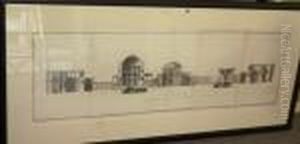Francesco Zucchi Paintings
Francesco Zucchi was an Italian painter and printmaker who was born in 1692 in Venice, Italy. He was part of a family of artists; his brother Antonio Zucchi was also a notable painter and printmaker. Francesco Zucchi is often less well-known than his brother but still made contributions to the Venetian art scene of the 18th century.
Zucchi's career was primarily focused on engraving, although he did engage in painting as well. His style was influenced by the Baroque movement, which was dominant during his time, but he also incorporated elements of the emerging Rococo style, characterized by lighter themes, ornate decoration, and a focus on leisurely subjects.
Throughout his career, Zucchi worked on religious and historical subjects, but he also engraved portraits and landscapes. He was recognized for his technical skill in engraving, which allowed for a high degree of detail and delicacy in his work. His engravings were often reproductions of paintings by other artists, which was a common practice at the time to disseminate artworks more widely.
Zucchi's work was part of the art collections of some of the notable figures of his time. He also collaborated with other artists, contributing engravings to various art publications and projects. His engravings were appreciated for their clarity and finesse, and they were instrumental in propagating the Venetian style across Europe.
Francesco Zucchi died in 1764 in Venice. His contributions to the art of engraving remain part of the study of 18th-century Italian printmaking, and his works are held in various art museums and collections around the world. Although his name may not be as well-known as some of his contemporaries, Zucchi's work provides valuable insights into the artistic transitions of his era from the Baroque to the Rococo and the role of printmaking in the diffusion of artistic styles.





